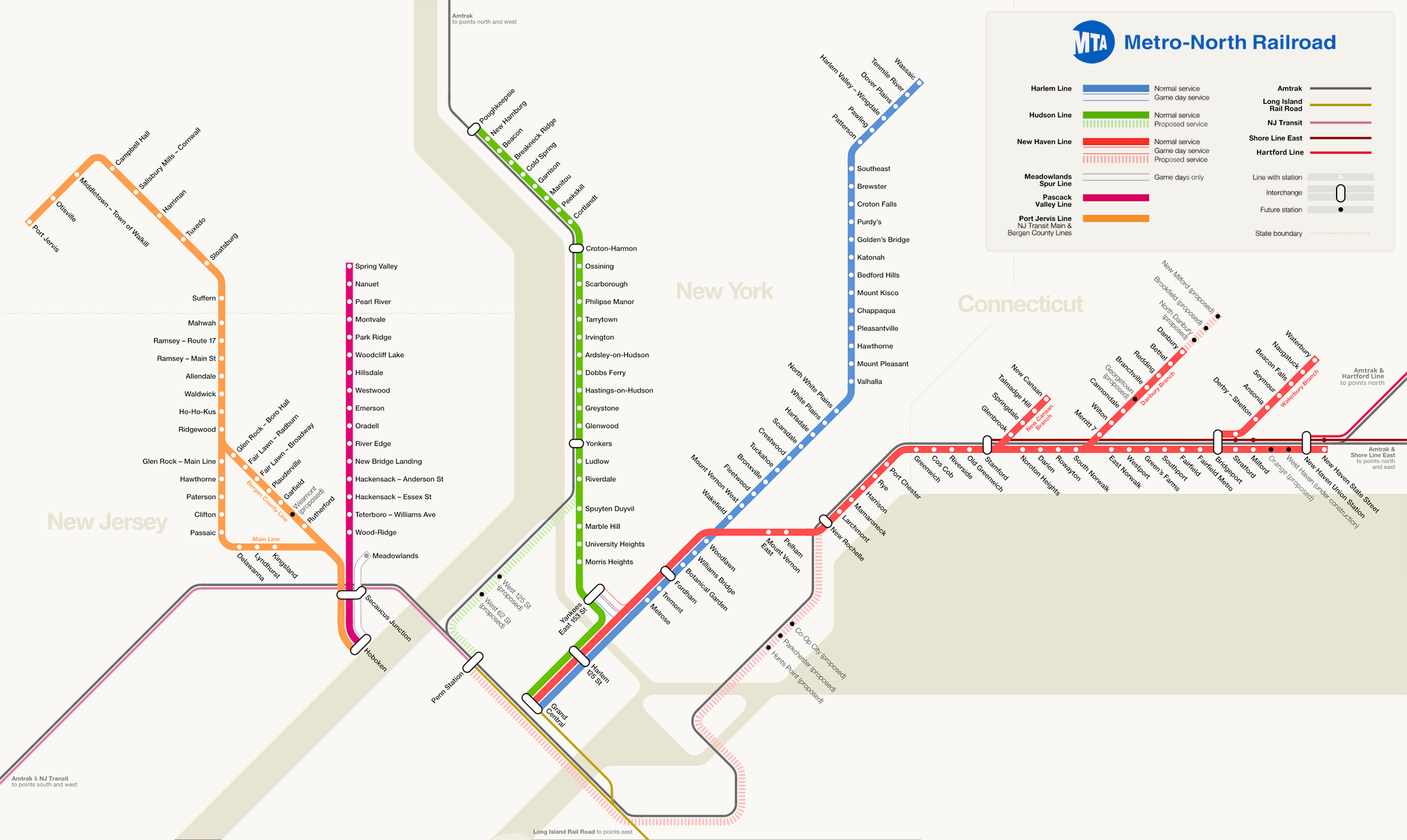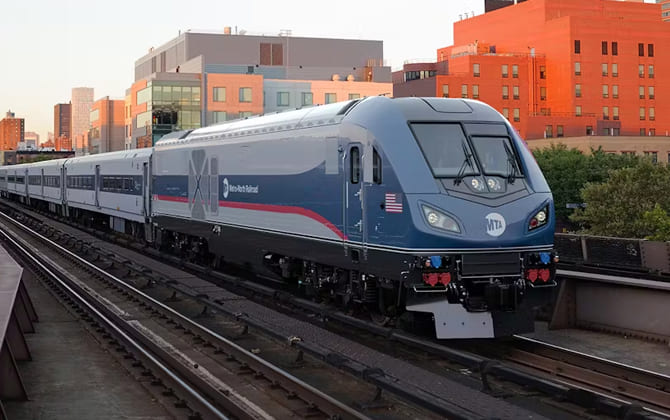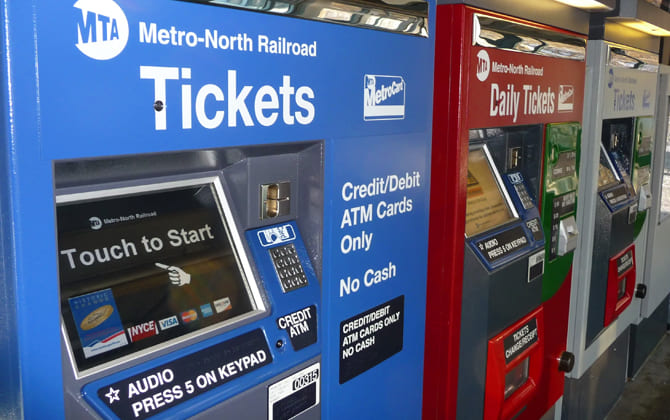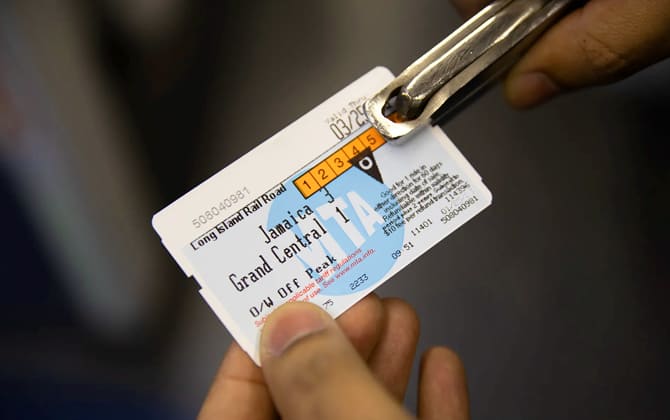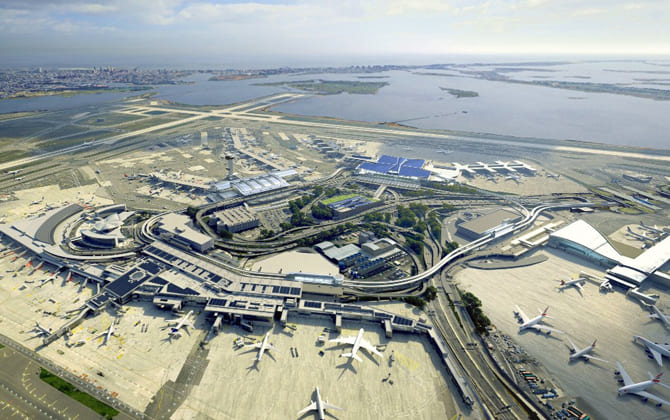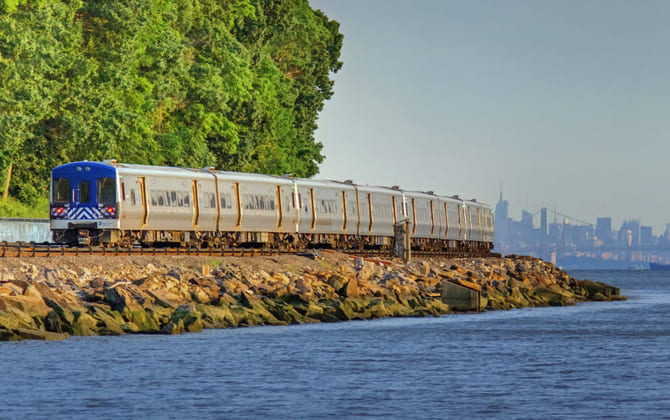Metro-North Railroad (MNR) is a commuter rail service in the New York metropolitan area, operated by the Metropolitan Transportation Authority (MTA). It links Grand Central Terminal in Manhattan with suburbs in New York’s Hudson Valley and neighboring Connecticut. The system has five main lines and three branch lines, serving 124 stations. In early 2026, an average weekday sees about 230,700 riders, and annual ridership reached 67.8 million in 2024. Metro-North is the second-busiest commuter railroad in North America after the Long Island Rail Road. Its network spans 787 miles (1,267 km) of track, with 385 miles (620 km) of active routes reaching Poughkeepsie and Wassaic in New York, New Haven in Connecticut, and Port Jervis in New York. The railroad traces its roots to 19th-century lines and became part of the MTA in 1983. Known for its reliability and scenic Hudson River views—especially on the Hudson Line—Metro-North serves daily commuters and travelers alike. This 2026 guide covers its map, lines, schedules, fares, stations, connections, and practical tips for smooth travel.
Metro-North Railroad Map
The Metro-North Railroad map shows all lines and stations across New York and Connecticut. It includes the three East-of-Hudson lines radiating north from Grand Central Terminal—the Harlem, Hudson, and New Haven lines, with New Haven’s branches—as well as the two West-of-Hudson lines (Port Jervis and Pascack Valley) operated by NJ Transit. Major interchanges like Grand Central and connections to other transit services are marked. Metro-North maps also appear at major stations and inside train cars. Carrying a copy helps you visualize routes, branches, distances, and transfer points. The map highlights ferry links—such as the Hudson River ferries at Beacon and Ossining—and connections to Amtrak at certain stations. In short, the map is essential for understanding the network’s layout.
Map of Metro-North showing its lines and stations. Click on the map to enlarge it or download the Metro-North Metro map in PDF format.
Metro-North Railroad Lines and Stations
Metro-North serves 124 stations across several lines north of New York City.
Harlem Line – Runs north from Grand Central Terminal through the Bronx into Westchester County, then continues into Putnam and Dutchess Counties. Major stops include Harlem–125th Street (Manhattan), Fordham (Bronx), White Plains (Westchester), Southeast (Brewster, NY), and Wassaic (terminus). There are 38 stations on this line. It is electrified up to North White Plains/Southeast, with diesel service beyond. The full route from Grand Central to Wassaic spans about 82 miles (132 km). Along the way, it serves communities such as Scarsdale and Chappaqua. A unique flag-stop at Appalachian Trail serves hikers on weekends.
Hudson Line – Follows the Hudson River north from Grand Central through the Bronx and Hudson Valley, ending in Poughkeepsie (terminus). Key stations include Yankees–E. 153rd Street (Bronx), Yonkers, Tarrytown, Ossining, Croton-Harmon (major transfer and maintenance yard), Beacon, and Poughkeepsie. This line has 29 stations and is known for river views and historic towns. It shares tracks with Amtrak’s Empire Corridor; Amtrak stops at Yonkers, Croton-Harmon, and Poughkeepsie. It is electrified to Croton-Harmon, with diesel service to Poughkeepsie (about 73 miles/117 km from Manhattan). Breakneck Ridge station is closed for improvements (April 2026) and expected to reopen in 2027.
New Haven Line – Travels from Grand Central along the Long Island Sound coast into Connecticut, terminating at New Haven. Stops include New Rochelle (NY), Stamford (CT), Bridgeport (CT), and New Haven (CT). It is the longest, busiest line, with 17 stations in New York and 12 in Connecticut (29 total to New Haven) plus three branches. Overhead catenary power is used in Connecticut; third-rail in New York. Branches include:
- New Canaan Branch – Runs from Stamford to New Canaan, CT, with intermediate stops like Darien.
- Danbury Branch – From South Norwalk or Stamford to Danbury, CT.
- Waterbury Branch – Runs from South Norwalk to Waterbury, CT.
Branch trains usually require transfers at Stamford or South Norwalk. Stamford and New Haven are major hubs: Stamford offers 62-minute express runs to Grand Central. In total, the New Haven Line network has around 44 stations, including branch termini.
West-of-Hudson Lines (Port Jervis & Pascack Valley) – These lines serve Orange and Rockland Counties in New York and parts of New Jersey. NJ Transit operates them under contract with Metro-North. They do not serve Grand Central but connect to Hoboken Terminal and New York Penn Station via NJ Transit.
Port Jervis Line – Runs from Hoboken or Penn Station through northern New Jersey into Orange County, NY, ending at Port Jervis (terminus). Major stops include Suffern (NY), Harriman (for Woodbury Common Outlets), and Middletown. Metro-North owns the New York State stations and tracks. Riders heading to Manhattan transfer at Secaucus Junction for Midtown Penn Station or go to Hoboken for a PATH connection.
Pascack Valley Line – Also starts at Hoboken or Penn Station (via Secaucus) and travels through Bergen County, NJ, into Rockland County, NY, ending at Spring Valley (terminus). It is a single-track line with limited peak service.
Key Hubs and Coverage – Grand Central Terminal in Manhattan is the main hub for the East-of-Hudson lines (Harlem, Hudson, New Haven). Opened in 1913, it features Beaux-Arts architecture and many amenities. In the Bronx, Harlem–125th Street station is a secondary hub where all East-of-Hudson lines stop, providing access to Upper Manhattan and Harlem.
Metro-North’s service area covers seven counties in New York (Bronx, Manhattan, Westchester, Putnam, Dutchess, Rockland, Orange) and two in Connecticut (Fairfield, New Haven). Major suburban stations—White Plains, Stamford, Yonkers, New Rochelle—are key ridership centers with connecting services. Each station falls into a fare zone (more on fares later). For station locations and addresses, use the MTA’s station lookup tool. Most stations have ticket vending machines and parking. Understanding your line and station is the first step to planning any trip, whether daily commuting or a day trip to the Hudson Valley.
In summary, Metro-North’s lines and stations are organized to connect New York City’s core with its northern suburbs. Each line serves a distinct corridor:
- Hudson Line – West side Hudson River towns to Poughkeepsie.
- Harlem Line – Central/northeast suburbs to Wassaic.
- New Haven Line – Connecticut coast to New Haven, with branches to New Canaan, Danbury, Waterbury.
- Port Jervis Line – West-of-Hudson via NJ to Port Jervis.
- Pascack Valley Line – West-of-Hudson via NJ to Spring Valley.
Metro-North Railroad Schedule & Timetable (2026)
Metro-North runs frequent trains during peak hours and regular service all day. In 2026, timetables were adjusted to match rising ridership.
Metro-North Railroad Operating Hours Today
The railroad is not 24/7. On weekdays, the first inbound trains from outer terminals depart around 4:00–5:00 AM. First outbound trains from Grand Central leave by about 5:30 AM. Service peaks during the morning rush.
Last departures from Grand Central run between midnight and 1:30 AM, depending on the line. On the New Haven Line, the final train leaves Grand Central at 1:50 AM, arriving in New Haven in the early morning. Other lines have similar last departures: the Hudson Line’s last train departs around 1:15–1:30 AM, and the Harlem Line’s last to Wassaic leaves around 1:20 AM. After these runs, service gaps occur roughly from 2:00 AM to 5:00 AM for maintenance. Grand Central Terminal closes during this time (approx. 2:00 AM to 5:15 AM) for cleaning and security. Always check your specific station’s schedule; branch lines sometimes end earlier. For up-to-date “last train” information, use the MTA online Metro-North Railroad schedule or the TrainTime app on your day of travel.
Frequency & Train Schedule
Service frequency varies by line and time of day.
- Weekday Peak Hours (approx. 6–10 AM inbound, 4–8 PM outbound): Major lines run trains every 10–20 minutes or more, counting both local and express services. For example, the Harlem Line may run 8+ trains between 7–8 AM from various outer stations. The New Haven Line offers 6–10 trains per hour during peak, mixing local and express runs. Expect crowded trains and some express services skipping stops.
- Weekday Midday (non-peak): Main lines run about every 30 minutes. Outer segments may see hourly service (e.g., Hudson Line north of Croton-Harmon). Branch lines vary: New Canaan typically every 60 minutes with timed connections at Stamford; Danbury every 3–4 hours; Waterbury every 2–3 hours (sometimes replaced by buses during maintenance, though train service is resuming with new signals).
- Weekday Evenings (post-8 PM): Service is mostly hourly, with half-hourly on inner segments in early evening. After 10 PM, expect about one train per hour or slightly less. For example, New Haven Line trains from Grand Central depart at 10:07 PM, 11:07 PM, 12:22 AM, and 1:50 AM.
- Weekends: Main lines run roughly every 30 minutes inbound (late morning to evening) and hourly outbound in the early morning, shifting to half-hourly after about 11 AM. For instance, the Hudson Line pairs an hourly local to Croton-Harmon with an express to Poughkeepsie. The New Haven Line has two trains per hour each way (some to Stamford, some to New Haven). The Harlem Line runs two trains per hour to North White Plains and hourly to Southeast/Wassaic. Branch lines have limited weekend service: New Canaan every 2 hours; Danbury and Waterbury have very limited schedules (Waterbury may use buses due to track upgrades).
- Late-Night Service: A few final trains run between midnight and about 1:30 AM. After ~2:00 AM, no trains operate until early morning.
Metro-North Railroad Ticket Prices & Fares
Metro-North uses a distance-based fare system. Fares depend on your origin, destination, and whether you travel at peak or off-peak times. All prices are in US dollars (USD), which is the local currency. Peak fares apply on weekdays for trains arriving at Grand Central between 6:00 and 10:00 AM, and departing Grand Central between 6:00 and 9:00 AM or 4:00 and 8:00 PM. Off-peak fares apply at all other times, including weekends and holidays. Off-peak tickets cost about 26 % less than peak fares. If any part of your trip falls under peak hours, you must use a peak ticket. Conductors enforce proper fares; using an off-peak ticket on a peak train incurs an onboard surcharge. Weekend travel is always off-peak.
Metro-North Railroad Fare Calculator
The simplest way to calculate your fare is to use the MTA TrainTime app or the MTA website’s trip planner. Enter your starting station and ending station, and the tool shows peak and off-peak fares, any New York City zone exceptions (like CityTicket), and discounts (senior, etc.).
If you prefer printed tables, each station belongs to a fare zone. You cross-reference the origin and destination zones on a fare table. For example, Grand Central is Zone 1, and White Plains is Zone 5. Looking up Zone 1 to Zone 5 gives the fare for that trip.
Here are sample one-way fares in 2026, all from Grand Central (Zone 1):
- Zone 1 to Zone 2 (e.g., Grand Central to Yankees–E. 153rd Street or Fordham): US$10.00 peak, US$7.50 off-peak.
- Zone 1 to Zone 1 (e.g., Grand Central to Harlem–125th Street): US$8.50 peak, US$6.25 off-peak.
- Zone 1 to Zone 5 (White Plains, ~22 miles/35 km north): US$15.25 peak, US$11.25 off-peak. Monthly pass: US$299.75.
- Zone 1 to Stamford, CT (~33 miles/53 km north): US$14.25 peak, US$10.75 off-peak. (Stamford falls under a special Connecticut fare table.)
- Zone 1 to New Haven, CT (~72 miles/116 km): Approximately US$23.50 peak, US$17.50 off-peak.
- Zone 1 to Zone 8 (Poughkeepsie, ~73 miles/118 km): US$24.00 peak, US$17.75 off-peak. Monthly pass: US$446.50.
Round-trip fares are simply double the one-way fare. There is no additional discount for round trips; a round-trip ticket is valid for 60 days. Weekly unlimited passes cost about the same as ten one-way peak rides. Monthly passes cost roughly 30 one-way peak fares, with a built-in discount for frequent riders. For example, a Zone 4 monthly is US$260; Zone 5 is US$300; Zone 8 is US$446.
Buying a ticket on board, when machines or ticket offices were available at your departure station, adds a surcharge of US$5–US$7 (off-peak) or US$5–US$7 (peak). Onboard fares may reach up to US$15 for a short trip. Always purchase tickets before boarding (via the app or station machine) to avoid extra fees. Conductors accept cash on board but no credit cards.
Intermediate (Intra-suburb) fares apply when travel does not involve Manhattan. Those tickets cost the off-peak rate at all times. For example, traveling from White Plains to Yonkers during rush hour still uses the off-peak fare, since neither endpoint is Grand Central.
Ticket Types and Day Pass
All standard tickets (except monthly) are valid for 60 days after purchase. Once you activate a paper ticket or use it on the app, it is considered used.
- One-Way and Round-Trip Tickets: One-way tickets cover a single ride between two stations. Round-trip tickets include two rides (outbound and return) and can be used in either order within 60 days. Off-peak tickets are valid only on off-peak trains; using them on peak trains requires a surcharge. For travel entirely within New York City, the CityTicket (US$5 off-peak, US$7 peak) is cheaper than a regular Zone 1–3 fare.
- Ten-Trip Ticket: A booklet of ten one-way rides, valid for six months. You can buy ten-ride booklets for peak, off-peak, or intermediate fares. Rides are transferable and marked by fare type. For example, a Zone 4 (White Plains) ten-trip off-peak costs US$83.00 (versus US$97.50 if buying ten individual off-peak tickets). Using a ten-trip off-peak ride on a peak train triggers a surcharge.
- Weekly Unlimited Pass: Allows unlimited rides between two specified stations (or any stations within those zones) for seven consecutive days. Valid Monday to Sunday or seven days from first use if purchased in the app. Price equals about seven to eight one-way fares. For instance, a Zone 5 weekly pass costs US$106.50. If you commute Monday–Friday and make a weekend round trip, a weekly pass can save money.
- Monthly Unlimited Pass: Offers unlimited rides between specified stations for a calendar month. Prices equal about 30 one-way peak fares, with a discount. For example, a monthly pass from Grand Central to Zone 5 (White Plains) costs US$299.75. Monthly passes used to be on MetroCard (for transfers to subways/buses), but as of May 25, 2026, MetroCard functionality is being phased out. Monthly passes are now paper. OMNY/contactless is used for subway and bus access. Weekly and monthly passes allow travel at any time—peak or off-peak.
- Off-Peak Round-Trip (Same-Day) Ticket: Two off-peak one-way tickets bundled for same-day use. There is no additional discount beyond buying two off-peak tickets, but machines may offer this as a convenience for leisure travelers.
- CityTicket: Valid for trips entirely within New York City. Costs US$5 off-peak and US$7 peak (unchanged since 2023). A CityTicket covers one way. Eligible stations include Grand Central, Harlem–125th Street, Yankees–E. 153rd Street, and all Bronx stations. Regular Zone 1–3 fares range from about US$7.50 off-peak to US$10.00 peak, so CityTicket offers significant savings. Off-peak CityTickets work on weekends (off-peak all day). Introduced in 2004 for weekend travel, CityTicket expanded to weekdays in 2022, and the US$7 peak price started in 2023. Use CityTicket on the day of purchase; it cannot be used later.
- Combo Ticket (Railroad Transfer): If you need to transfer between Metro-North and Long Island Rail Road (LIRR) at Grand Central, you can buy a Combo Ticket with an US$8 add-on. For example, a trip from White Plains to Jamaica via Grand Central Madison requires a Metro-North ticket plus the US$8 LIRR add-on. Combo Tickets simplify cross-region travel.
- Reduced Fares (Seniors/Disabled/Children): Seniors (65+), people with disabilities, and Medicare cardholders pay half the one-way fare, except on weekday morning inbound peak trains. Off-peak and weekend travel always qualifies for half fare. Children under 5 ride free with an adult (up to three children). Children 5–11 ride for US$1 off-peak when accompanied by an adult (up to four children per adult). On weekday morning peak inbound trains, children 5–11 pay half fare. Children 12 and over pay full fare. This family-friendly policy makes weekend travel affordable.
- Student Fares: Students under 21 attending school can buy a monthly school ticket at about one-third off the regular monthly rate. Schools must sign applications. These tickets are valid only for travel between specified stations on school days.
- Group Tickets: Groups of ten or more may get discounts. For 30 or more passengers, book a one-day round-trip group ticket at a reduced rate. Smaller groups (10–29) can use ten-trip tickets or inquire about group rates in advance.
- Military: Active-duty military travel at off-peak fares at all times (including peak), with uniform or military ID.
- Rail Passes: Metro-North does not offer a day pass for unlimited system-wide travel. For a single day of exploration, buy point-to-point tickets as needed. Occasionally, “Getaway” packages bundle rail fare with attraction admission, but these are special promotions, not standard fare products.
How Much Does Metro-North Railroad Cost?
Typical fares in 2026 range from about US$6–US$7 for a short off-peak ride within New York City, up to around US$24 for a long-distance peak trip to the farthest stations. Most common commutes (20–40 miles/32–64 km) cost roughly US$10–US$15 one-way off-peak, or US$15–US$20 peak.
Examples:
- Grand Central to Yonkers (just outside NYC): ~12 miles (19 km). One-way fare: US$8.00 off-peak, US$12.00 peak.
- Grand Central to White Plains (~22 miles/35 km): US$11.25 off-peak, US$15.25 peak one-way.
- Grand Central to New Haven (~72 miles/116 km): US$17.50 off-peak, US$23.50 peak one-way.
- Grand Central to Southeast (Brewster) (~60 miles/97 km): US$18.00 off-peak, US$24.00 peak one-way.
- Hoboken to Port Jervis (~95 miles/153 km, via NJ Transit): US$17.00 off-peak, US$23.00 peak one-way (NJ Transit fares apply but are similar).
If you combine Metro-North with NYC subways or buses, budget an extra US$2.90 per subway or local bus ride (2026 base fare). Metro-North tickets do not include subway or bus transfers. A few legacy MetroCards allowed free transfers between commuter rail and subways, but MetroCard use is ending. OMNY/contactless is being extended to railroads in 2026, which may improve fare integration in the future.
Routes and Connections
Metro-North connects seamlessly with various transit modes in the New York area, including buses, subways, ferries, and shuttles. Below is a comprehensive guide to these connections.
Connections with New York Bus and Airports
Several Metro-North stations serve as intermodal hubs:
New York City Subway
Grand Central Terminal provides direct connections to subway lines 4, 5, 6 (Lexington Avenue), 7 (Flushing Line), and the Times Square Shuttle. Travelers can easily transfer within the station complex. To reach the West Side, take the Shuttle or 7 train to 5th Avenue.
In The Bronx, Fordham Station is a short walk from the B/D subway lines at Fordham Road, Woodlawn Station directly connects to the 4 subway terminus, and Harlem–125th Street is near the 4/5/6 lines at Lexington Avenue and the 2/3 lines at Lenox Avenue (separate fare required).
MTA and Bee-Line Buses
In Manhattan, buses such as M42, M101, M102, and M103 stop near Grand Central. In The Bronx, several Bx routes serve stations like Fordham and Parkchester. Westchester’s Bee-Line connects at Yonkers, Tarrytown, White Plains, and others, including a direct Route 12 from White Plains to Westchester County Airport (HPN). Connecticut’s CT Transit serves Stamford, Bridgeport, and New Haven, connecting various park-and-ride locations beyond rail lines.
Ferries
The Newburgh–Beacon Ferry and Haverstraw–Ossining Ferry, operated by NY Waterway under MTA contract, connect these Hudson River towns directly with corresponding Metro-North stations, timed with train arrivals. Fares are approximately $4.00 one-way, with UniTickets available for regular commuters.
Airports
Metro-North indirectly serves regional airports:
LaGuardia Airport (LGA) is accessible via Harlem–125th Street, connecting with the M60 SBS bus at 125th Street & Park Avenue (about 30–40 minutes to LGA).
John F. Kennedy Airport (JFK) can be reached via two primary routes from Grand Central: Subway 6 to E or Shuttle/7 to E, connecting to the AirTrain at Jamaica; or via LIRR from Grand Central Madison to Jamaica, then AirTrain.
Newark Airport (EWR) involves Metro-North to Grand Central, then transit via Port Authority and Newark Airport Express bus or transfer to Amtrak at Stamford and NJ Transit from Penn Station. Routes are less direct and more time-consuming.
Stewart International Airport (SWF) connects via Hudson Line to Beacon, with shuttle service by Leprechaun Lines.
Westchester County Airport (HPN) is served by Bee-Line Route 12 from White Plains station.
Intercity Trains
Key stations like New Rochelle and Stamford connect to Amtrak’s Northeast Corridor services. Yonkers, Croton-Harmon, and Poughkeepsie serve Amtrak’s Empire Service and Adirondack routes. West-of-Hudson lines connect at Secaucus Junction for NJ Transit and Amtrak Northeast Corridor services.
Future Expansions & Upcoming Lines
Metro-North plans significant improvements to extend its reach and service capacity.
Penn Station Access
By 2027, New Haven Line trains will serve Penn Station, adding four new Bronx stations (Co-op City, Morris Park, Parkchester/Van Nest, and Hunts Point). The project, costing approximately $3.2 billion, includes new tracks, upgraded signals, and dual-mode M8 railcars.
Hudson Line to Penn Station Study
A study under the 2026–2029 Capital Plan is evaluating potential direct Hudson Line service to Penn Station via Amtrak’s Empire Connection tunnel. This could happen in the 2030s, creating more flexibility for riders.
Harlem Line Third Track Project
An additional track from Crestwood to North White Plains is being considered to ease bottlenecks and improve service reliability, paralleling recent improvements by LIRR.
Fleet Modernization
New Siemens Charger SC-42 DM locomotives are expected to replace older diesel models starting in 2026. Plans also include acquiring M9A electric multiple unit cars for increased service to Penn Station by 2028.
West-of-Hudson Enhancements
With NJ Transit, Metro-North plans improvements including additional passing sidings on the Pascack Valley Line and potential new stations, such as near Woodbury Commons. Enhanced services to MetLife Stadium for events, particularly ahead of the 2026 World Cup, are also in development.
Potential Future Lines and Extensions
Extensions like the Harlem Line to Chatham or Hudson Line to Albany are speculative. The Beacon Line remains a rail-trail, with no current plans to restore passenger service. Electrification extensions are under discussion but costly; new dual-mode locomotives may mitigate this need.
Station and Infrastructure Upgrades: Ongoing improvements include White Plains, Harlem–125th Street renovations, and Bronx stations for Penn Access. Accessibility upgrades aim for 100% ADA compliance east-of-Hudson. Environmental projects include flood protections, renewable energy initiatives, and enhanced sustainability measures.
Service and Technology Enhancements: Metro-North is adjusting to hybrid work patterns, expanding off-peak services, and integrating OMNY fare payment by late 2026, with simplified fare structures and unified transfers.
